Medical Disclaimer: This article is for informational purposes only and does not replace professional veterinary advice. Always consult your veterinarian before beginning any treatment.
Table of Contents
Introduction
If you’ve ever watched your aging pup struggle to climb stairs or deal with chronic pain, you know how hard it is to feel helpless. As a small-animal vet in Ottawa, I’ve seen firsthand how dog acupuncture points can make a huge difference. One of my Labrador patients, Max, regained mobility and even wagged his tail again after just a few sessions. That’s why this acupuncture guide for dogs is close to my heart.
This article is your go-to resource for understanding canine acupuncture charts, how acupuncture works, and how it can help manage pain, anxiety, digestive issues, and more. Whether you’re considering alternative therapies or looking to supplement traditional care, this guide to dog acupuncture points will walk you through everything you need to know safely and effectively.
Key Takeaways
- Acupuncture is a complementary therapy not a replacement for conventional veterinary care.
- Dog acupuncture are specific locations on a dog’s body used to relieve pain, improve mobility, and support healing.
- These points are mapped on a canine acupuncture chart, based on Traditional Chinese Medicine (TCM) meridian systems.
- Modern science shows acupuncture can stimulate nerves, improve circulation, and trigger natural pain relief.
- This dog acupuncture guide covers what it treats, how it works, costs in Canada, and what to expect during sessions.
- Acupuncture is generally safe when performed by a certified veterinary acupuncturist. It’s especially helpful for arthritis, anxiety, and post-surgical recovery.
- Pet owners can also use basic canine acupuncture knowledge for at-home acupressure (no needles).
What Is Acupuncture for Dogs?
you can visit: https://doglifeexpert.com/dog-diarrhea-10-best-expert-backed-home-remedies/
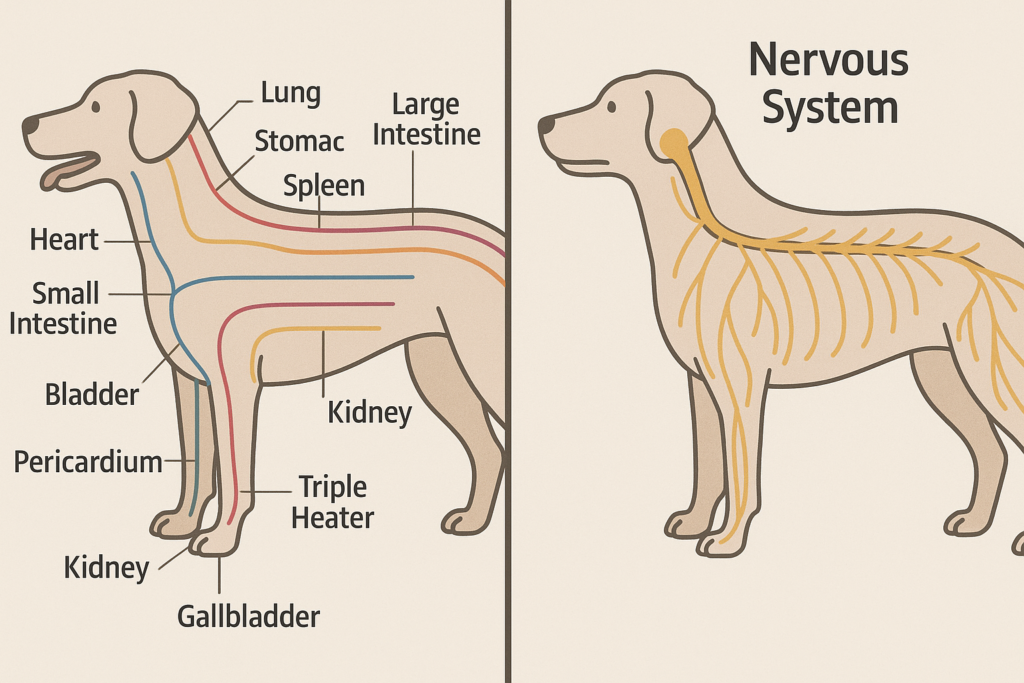
Acupuncture is a therapeutic practice that involves stimulating specific dog acupuncture points using thin, sterile needles. Rooted in Traditional Chinese Medicine (TCM), this technique has been adapted for veterinary use and is increasingly supported by modern science. In clinical settings, it’s often used to manage pain, improve quality of life, and support healing in dogs with chronic conditions.
Traditional Chinese Medicine vs. Western Medicine
In TCM, health is believed to depend on the balanced flow of vital energy, called Qi, through meridians channels that connect organs and systems. Canine acupuncture charts map out these meridians and highlight the acupuncture points of dogs that influence Qi flow. Disruptions in Qi may cause illness or discomfort, and acupuncture is used to restore harmony.
From a Western standpoint, acupuncture works by activating nerves and triggering biochemical changes. When a needle is inserted into a dog acupuncture point, it can:
- Stimulate endorphin release (natural painkillers)
- Improve blood flow and oxygenation
- Reduce inflammation
- Enhance immune response
These dual perspectives support why acupuncture is considered a powerful, holistic option in modern veterinary practice.
Common Conditions Treated
A well-structured acupuncture guide can help pet owners understand that acupuncture isn’t just for pain. It’s used as a complementary treatment for:
- Arthritis and hip dysplasia
- Neurological disorders (e.g., seizures, IVDD)
- Digestive problems (vomiting, diarrhea)
- Anxiety and noise phobia
- Post-operative recovery
- Cancer support
- Urinary issues
- Skin allergies
This acupuncture guide for dogs is particularly useful when conventional treatments cause side effects or when managing long-term care. Understanding the specific dog acupuncture points for each condition allows for targeted, effective therapy.
How Dog Acupuncture Points Work
Understanding how dog acupuncture points function gives insight into why this therapy works so well especially when conventional treatments fall short. Both Traditional Chinese Medicine (TCM) and Western veterinary science offer complementary explanations for its success.
Traditional Chinese Medicine (TCM) View
In TCM, dog acupuncture points lie along energy pathways called meridians. There are 12 paired meridians and two extra ones (Governing Vessel and Conception Vessel), each linked to different organs. By stimulating specific points, acupuncturists aim to balance Qi (vital energy), improve organ function, and promote healing.
A canine acupuncture chart organizes these points based on their location and function. For example:
- ST-36 (Stomach 36): Below the knee; boosts energy, helps digestion, and supports the immune system.
- GV-20 (Governing Vessel 20): Top of the head; calms anxiety and supports neurological health.
- BL-23 (Bladder 23): Near the spine; supports kidney health and reduces back pain.
These are just a few examples used routinely in this acupuncture guide for dogs.
Western Scientific Explanation
From a Western perspective, acupuncture works by stimulating the nervous system. Many dog acupuncture points are located near major nerves, blood vessels, or muscle groups. When stimulated, they:
- Send signals to the brain and spinal cord
- Trigger the release of endorphins and serotonin
- Modulate the immune system
- Improve circulation and oxygenation
- Reduce muscle spasms and pain
In clinical practice, I’ve seen senior dogs with chronic arthritis get off anti-inflammatory drugs after consistent acupuncture sessions. This cross-functional approach, combining insights from a canine acupuncture chart and modern science, allows us to treat dogs more holistically.
Table: Average Cost of Dog Acupuncture in Canada
| Type of Session | Typical Cost (CAD) |
|---|---|
| Initial Consultation | $120–$180 |
| Follow-Up Session | $80–$120 |
| Acupressure Session | $50–$75 |
| Herbal Medicine Add-On | $30–$60 |
Prices vary depending on the clinic and whether the vet is IVAS- or TCVM-certified. While not always covered by pet insurance, some plans now include alternative therapies check with your provider.
5‑Minute Home Preparation Checklist
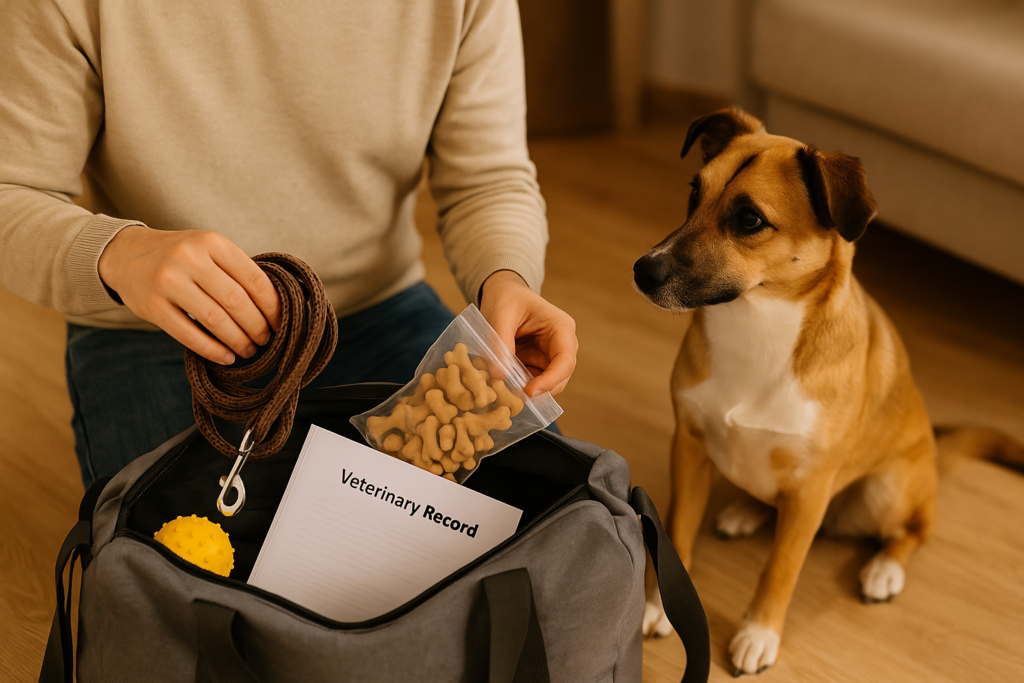
Before you head to your first acupuncture appointment, a little prep can make the experience smoother for both you and your dog. This part of the acupuncture guide for dogs helps you get organized quickly and safely.
✅ Quick Checklist Before Your Dog’s Session:
- ✔ Discuss your dog’s full medical history with the veterinary acupuncturist, including medications and supplements.
- ✔ Bring any X-rays, lab results, or reports from your regular vet.
- ✔ Avoid feeding your dog a full meal right before the session give a light snack at most.
- ✔ Make sure your dog has gone to the bathroom before the visit.
- ✔ Bring a leash, harness, and favorite calming toy or blanket.
- ✔ Write down observed symptoms or changes you’ve noticed (e.g., limping, anxiety triggers, vomiting episodes).
- ✔ Review the clinic’s website or your practitioner’s credentials (look for IVAS or Chi University certification).
This preparation helps your veterinarian make the most of each session. It also lets you track which dog acupuncture points were used and how your pet responded especially helpful if you’re following a canine acupuncture chart over time.
Even at home, this checklist supports any owner-led acupressure program, which we’ll cover later in this acupuncture guide for dogs.
https://vcahospitals.com/know-your-pet/acupuncture-acupressure-for-dogs
Essential Points in the Canine Acupuncture Chart

Hundreds of dog acupuncture points are located across your dog’s body, but some are used more frequently than others for their proven effects on pain relief, organ health, and emotional balance. This section of the acupuncture guide for dogs outlines the key points you’re most likely to encounter and why they matter.
Common Dog Acupuncture Points and What They Treat
| Meridian | Point | Location | Uses |
|---|---|---|---|
| ST | ST-36 | Below knee, outside front leg | Digestion, energy, immune support |
| BL | BL-23 | Lower back, near kidneys | Back pain, kidney function |
| LI | LI-4 | Between paw bones (front foot) | Pain relief, dental pain, immune support |
| GV | GV-20 | Top of head, midpoint between ears | Anxiety, calming, neurological support |
| PC | PC-6 | Inner forelimb, above wrist | Nausea, vomiting, emotional regulation |
Each of these dog acupuncture points plays a unique role in restoring Qi and supporting body functions. When mapped together on a canine acupuncture chart, they allow your veterinarian to build a custom treatment plan tailored to your pet’s needs.
How to Read a Canine Acupuncture Chart
A canine acupuncture chart is a visual tool that helps practitioners (and even pet owners doing acupressure) locate specific points. These charts divide the dog’s body by meridian pathways and often use color-coding and anatomical references.
Great starter resources include:
- Atlantic Points Free Chart: Excellent visual of the 14 meridians.
- Body of Elements Poster: Lists all 100 numbered points with locations and uses.
- Chi University Texts: Used in professional training for TCM-certified vets.
These charts are particularly useful for identifying point combinations that support multiple symptoms, like using ST-36 and GV-20 together for energy and calm.
Whether you’re pursuing acupuncture professionally or simply curious, a canine acupuncture chart is a must-have for any thorough acupuncture guide for dogs.
Finding a Certified Practitioner
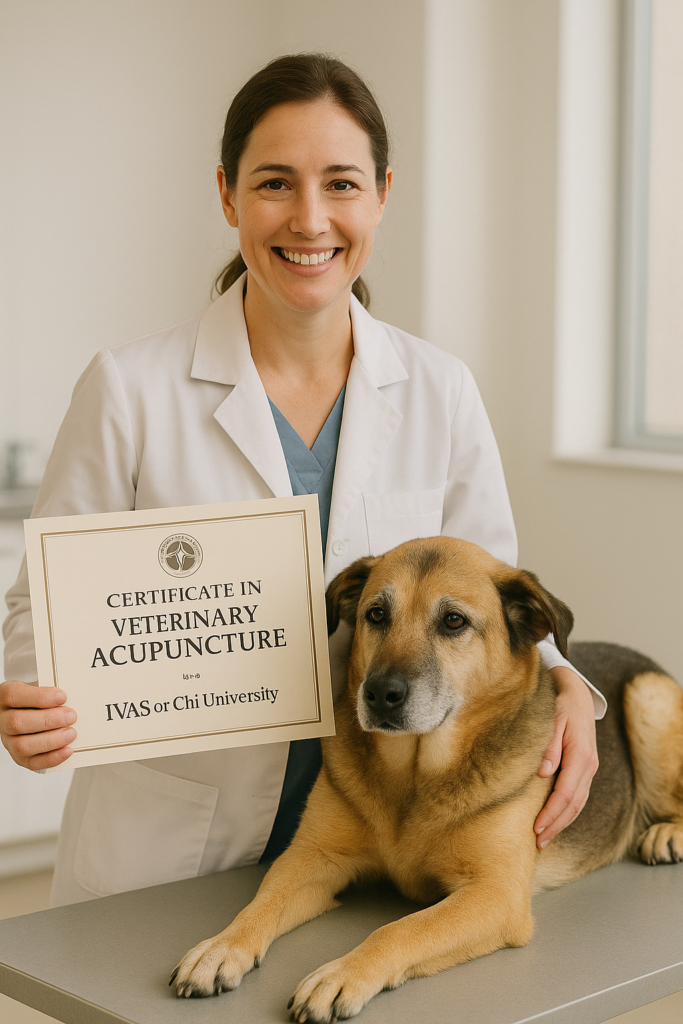
Choosing the right person to perform acupuncture on your pet is just as important as the therapy itself. This acupuncture guide for dogs emphasizes the need for experience, certification, and compassion when dealing with dog acupuncture points.
Questions to Ask Before Booking
- Are you a licensed veterinarian?
Only vets should insert needles in animals. If not, acupressure may be safer. - Where did you get your acupuncture training?
Look for certifications from: - Do you have experience with my dog’s condition?
If your dog has arthritis, seizures, or post-surgical needs, ask for case examples. - What kind of acupuncture methods do you use?
Some vets use electroacupuncture or laser therapy in addition to traditional needling. - Do you use a personalized treatment plan based on a canine acupuncture chart?
This ensures your vet is adapting therapy to your dog’s symptoms, not using a one-size-fits-all approach.
Red Flags to Watch For
- Practitioners who aren’t veterinarians but still offer needle-based acupuncture
- No certification from IVAS, Chi University, or equivalent
- No discussion of your dog’s full medical history
- Refusal to coordinate with your regular vet
When properly performed, acupuncture is extremely safe. But improper use of dog acupuncture points can cause harm, especially if done by someone unfamiliar with canine anatomy.
A good acupuncturist will refer to a canine acupuncture chart, explain each step of the session, and encourage your dog to relax during treatment often resulting in a nap or gentle tail wag halfway through.
Safety, Side Effects & Contraindications
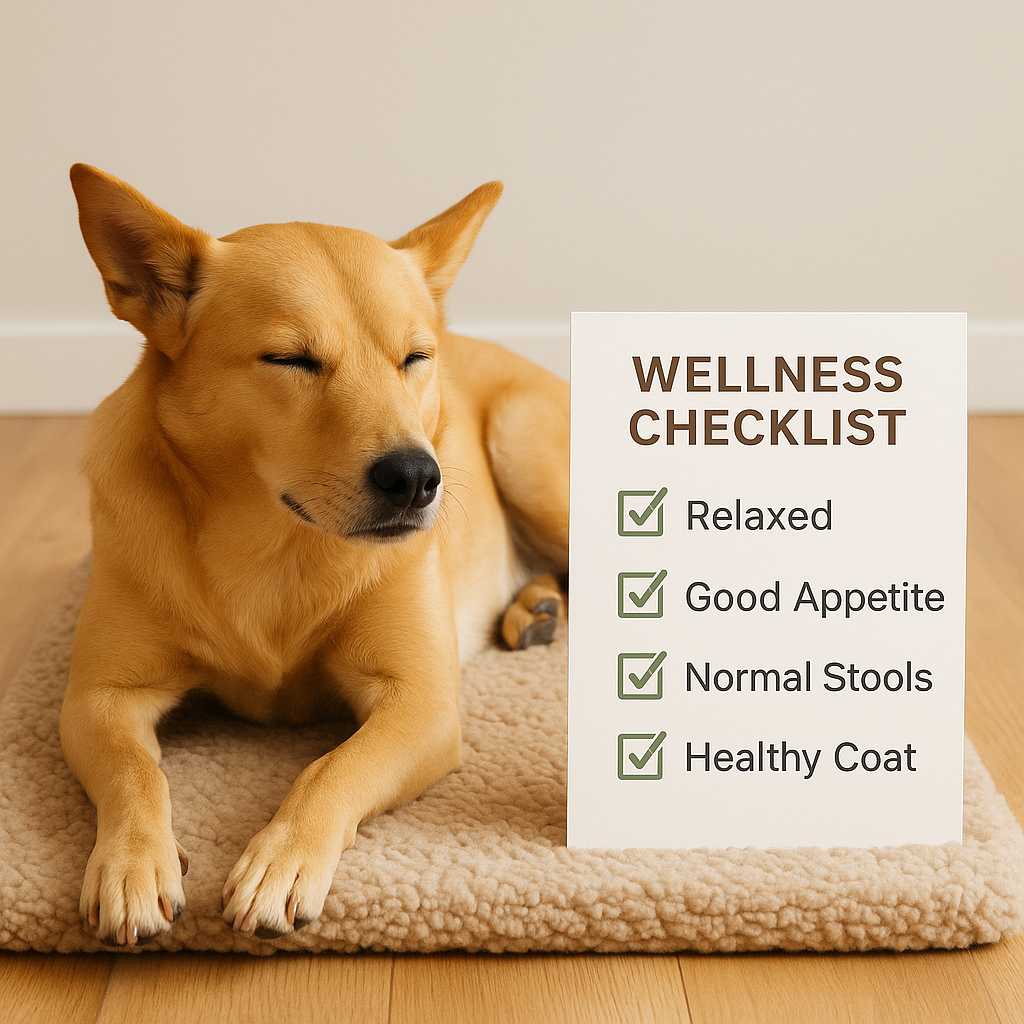
One of the most common concerns among dog owners exploring this acupuncture guide for dogs is: “Is it safe?” The short answer is yes dog acupuncture points are generally very safe when stimulated by a certified professional. However, like any treatment, there are a few considerations.
What to Expect After a Session
Most dogs tolerate acupuncture very well. In fact, many appear calm or even sleepy during treatment. After a session, your dog may:
- Seem relaxed or mildly drowsy for 24–48 hours
- Experience mild soreness at the needle site
- Show improved mobility or decreased anxiety
- Have increased urination or thirst (signs of detoxification)
These effects typically fade quickly and are considered normal. If your dog becomes very lethargic or distressed, contact your vet.
When to Avoid Acupuncture
Certain conditions may contraindicate the use of acupuncture or require special precautions:
- Bleeding disorders (e.g., hemophilia)
- Severe skin infections at point sites
- Cancerous tumors near common dog acupuncture points
- Fractures or open wounds at meridian locations
- Dogs who are extremely aggressive or too anxious to tolerate needle placement
These are reasons why your vet should review your dog’s history carefully and why proper use of a canine acupuncture chart matters accuracy is everything.
If you’re unsure whether acupuncture is appropriate, this acupuncture guide for dogs recommends discussing other holistic options like acupressure, supplements, or laser therapy as potential alternatives.
Always remember: acupuncture is a complementary therapy, not a replacement for medication or surgery in critical cases.
Acupressure vs. Acupuncture Guide for Dogs
If needles make you or your pup uneasy, don’t worry. This acupuncture guide for dogs also introduces a gentler, needle-free alternative: acupressure. Both methods target the same dog acupuncture points, but the technique and who can perform it differs.
What’s the Difference?
| Feature | Acupuncture | Acupressure |
|---|---|---|
| Performed by | Licensed veterinarian | Pet owner or trained technician |
| Tools used | Sterile needles | Fingers/thumb pressure |
| Regulation | Requires veterinary license | No license required, low risk |
| Use of chart | Canine acupuncture chart | Also uses canine acupuncture chart |
| Conditions treated | Chronic pain, anxiety, seizures | Mild pain, calming, minor stiffness |
When to Use Acupressure
You can safely stimulate dog acupuncture points at home using gentle finger pressure. It’s particularly helpful for:
- Mild arthritis
- Travel anxiety
- Motion sickness
- Muscle tension
Focus on points like ST-36 (for energy), GV-20 (for calm), and BL-60 (for back legs). Use a canine acupuncture chart to locate them accurately. Hold each point for 10–30 seconds while your dog is calm or resting.
While not as potent as acupuncture, acupressure is a great option for daily maintenance between professional treatments. It also empowers owners to be hands-on with their dog’s care something this acupuncture guide for dogs fully supports.
For detailed tutorials, websites like Animal Medical New City offer step-by-step videos and diagrams.
Holistic and Preventive Care Tips

Incorporating acupuncture into your dog’s wellness plan is just one part of a broader holistic approach. This section of the acupuncture guide for dogs offers practical ways to support your pet’s long-term health using complementary methods alongside stimulation of dog acupuncture points.
Prevention Is Better Than Cure
A consistent wellness routine can reduce your dog’s reliance on medications and prevent conditions that commonly require acupuncture. Here are some vet-approved strategies:
- Nutrition: Feed a balanced, species-appropriate diet with joint and immune support (e.g., omega-3 fatty acids, glucosamine).
- Exercise: Daily low-impact movement keeps joints mobile and Qi flowing especially important for aging pets.
- Massage: Combine basic massage with canine acupuncture chart points to enhance circulation and relaxation.
- Supplements: Consider herbal or integrative supplements, such as those recommended by TCVM practitioners.
- Environmental enrichment: Mental stimulation and social interaction can reduce stress and anxiety a common reason for GV-20 stimulation.
Incorporating Acupressure into Your Routine
Even if you’re not visiting a veterinary acupuncturist weekly, a quick five-minute acupressure routine can be part of your dog’s daily care. Focus on 2–3 key dog acupuncture points, such as:
- GV-20 (top of the head): For relaxation
- LI-4 (paw area): For immune support
- ST-36 (hind leg): For vitality and digestion
Use your canine acupuncture chart as a reference guide. The goal is gentle, regular maintenance not aggressive intervention.
Combining preventive care with regular check-ins from your vet helps ensure your dog stays as healthy as possible, making this acupuncture guide for dogs more than just a treatment plan it’s a wellness philosophy.
FAQs About Acupuncture Guide for Dogs
This section answers common pet owner questions about acupuncture. If you’re reading this acupuncture guide for dogs for the first time, these answers will help you decide if it’s right for your pet.
Does acupuncture hurt dogs?
Not usually. The needles used on dog acupuncture points are incredibly thin most dogs barely notice them. Some may feel a slight twitch or tingling. Many dogs relax or even fall asleep during treatment.
How many sessions will my dog need?
It depends on the condition. Acute problems (like post-op pain) might need 1–3 sessions. Chronic issues (like arthritis or anxiety) often require 4–8 weekly treatments, then monthly maintenance. A personalized plan based on a canine acupuncture chart will be created by your vet.
Can I use a canine acupuncture chart at home?
Yes for acupressure. While needle-based acupuncture must be done by a vet, you can use a canine acupuncture chart to locate points for gentle pressure therapy. This acupuncture guide for dogs includes tips for doing that safely.
Is it safe for older or sick dogs?
Absolutely. In fact, acupuncture is often used to help senior dogs manage arthritis, dementia, and decreased mobility. It’s minimally invasive and drug-free making it ideal for pets with organ issues or sensitivity to medications.
Will pet insurance cover acupuncture?
Some policies now include coverage for alternative therapies like acupuncture. Check with your provider and ensure treatment is performed by a certified veterinary acupuncturist. Mention that dog acupuncture points are being targeted for medically diagnosed conditions.
Final Thoughts: Should You Use This Acupuncture Guide for Dogs?
Whether your dog is battling arthritis, recovering from surgery, or suffering from anxiety, acupuncture may offer relief beyond traditional medicine. As this acupuncture guide for dogs has shown, the strategic use of dog acupuncture points based on a reliable canine acupuncture chart can unlock powerful healing responses.
From my own experience in general practice, I’ve seen dogs regain mobility, relax for the first time in weeks, and even improve appetite all thanks to targeted, compassionate acupuncture care.
To recap:
- Learn about core dog acupuncture points like ST-36 and GV-20.
- Refer to a canine acupuncture chart to understand how points affect different organs and symptoms.
- Choose a certified veterinary acupuncturist or trained TCVM vet.
- Use acupressure at home to extend benefits between sessions.
- Treat acupuncture as part of a holistic, preventive health plan.
This acupuncture guide isn’t just about needles it’s about connecting with your dog’s body in a safe, supportive way. When done right, acupuncture is more than treatment it’s a tool for lifelong wellness.

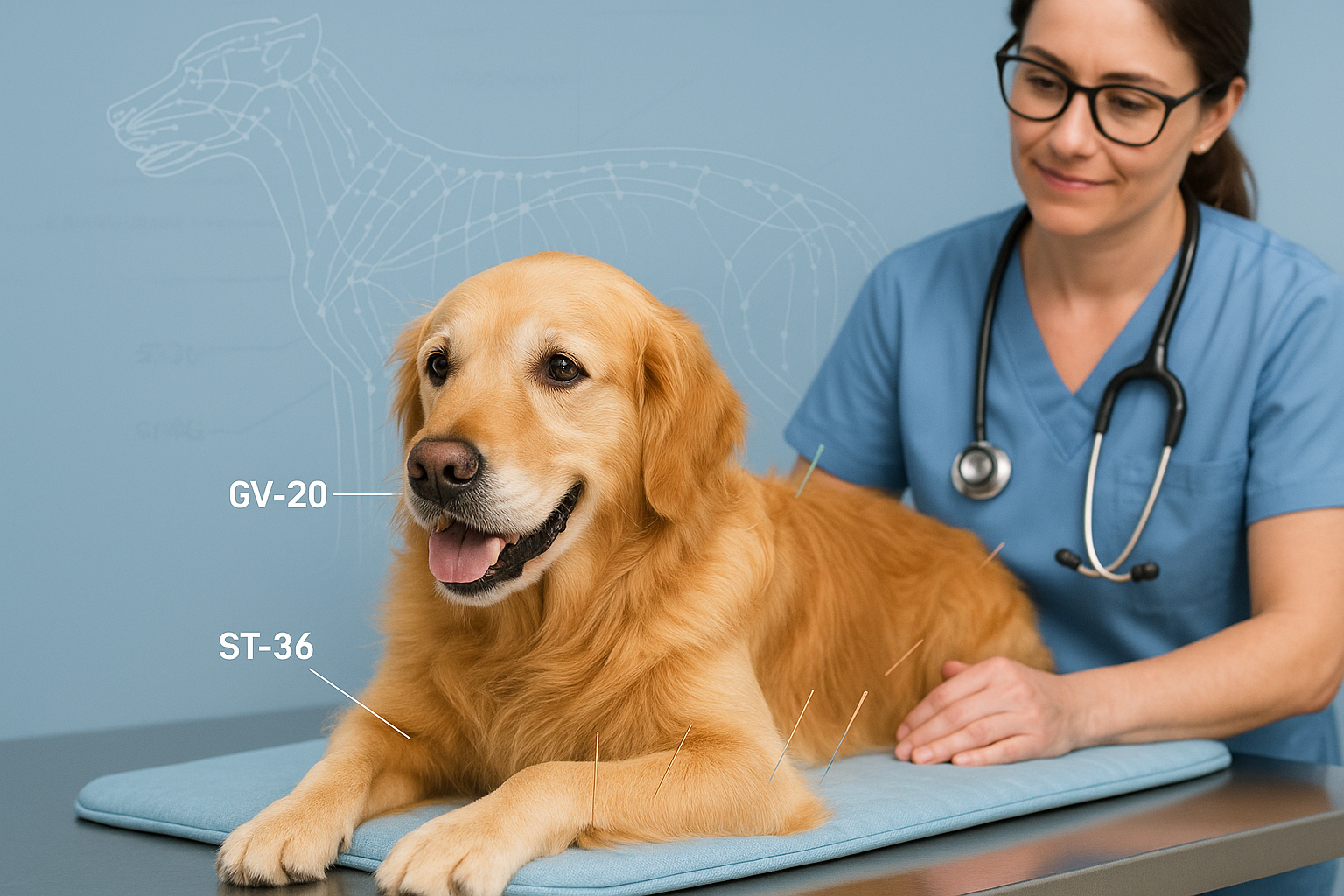

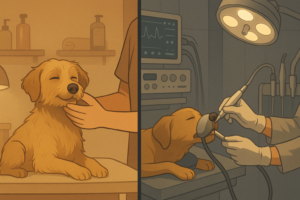
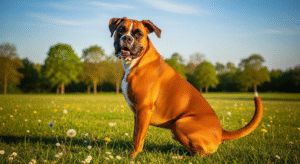
Pingback: Hydrotherapy for Dogs: 7 Proven Benefits That Speed Up Recovery